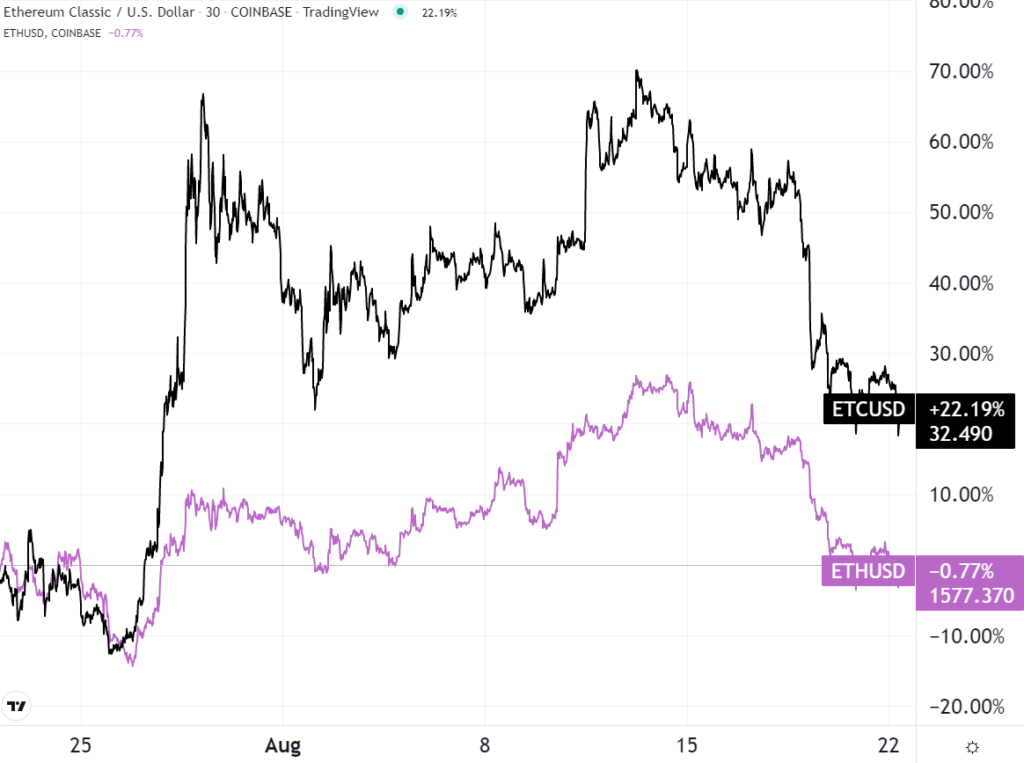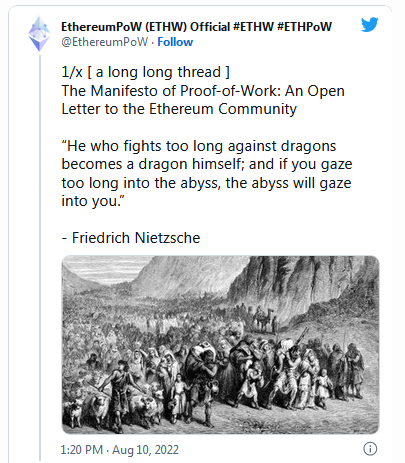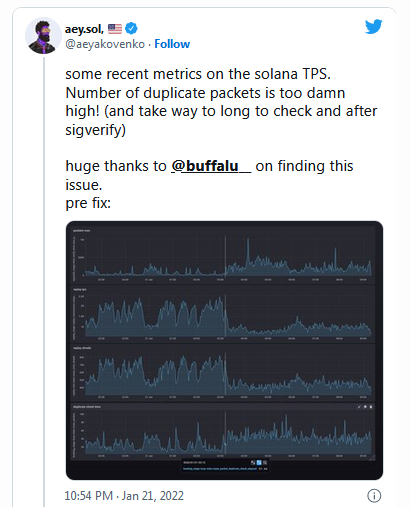Next 6-12 months crucial for prediction platforms like Kalshi and Polymarkets
Left out to dry ahead of the Merge, ETH miners are revitalizing other PoW networks.
In less than a month, the largest smart contract platform is scheduled to transition to a proof-of-stake (POS) network. As validators would soon replace miners, miners are scrambling to find alternatives. Interesting, Ethereum Classic (ETC) has been on a rally lately and outperformed ETH year-to-date.
Ethereum Classic (ETC) Gains the Upper Hand
Year-to-date, ETC outperformed Ethereum by +65%. In the last 30 days, the ETH/ETC dynamic has been especially volatile, owing to the Merge date ending closer.

As the name implies, Ethereum Classic (ETC) is the original network from which the Ethereum (ETH) network sprung. However, this didn’t happen because of some milestone upgrade, but because a hard fork was needed to retrieve funds stolen from The DAO hack.
This decentralized autonomous organization (DAO) was a vault for storing $150 million worth of ETH gained through Ethereum’s ICO sale. Some developers opted to reverse the hack by creating a new hard fork, the present Ethereum as we know it, waiting for the Merge.
The remainder stayed on a comparatively abandoned Ethereum Classic (ETC). At its highest peak, in May 2021, ETC reached a market cap of $15.6 billion, while Ethereum can boast to have reached a $569 billion market cap in November 2021. Both networks were designed to deploy dApps.
However, ETC has a maximum supply of 210.7 million coins, of which 65% are in circulation, while ETH has an unlimited token supply, counting on its fee-burning upgrade to exert anti-inflationary pressure.
Miner Displacement Boosts ETC and BTG with ETHPoW in the Sideline
According to Messari’s June report, once Ethereum ditches miners, a market worth $19 billion will seek new mining pastures. With ETH out of the mining equation, the rest of the GPU-mineable networks make up just $4.1 billion in market capitalization.
Unlike Bitcoin which relies on specialized ASIC miners, these networks rely on generic GPU hardware, available in every PC store. In addition to ETC, these GPU-mineable cryptocurrencies are Monero (XMR), Bitcoin Gold (BTG) Dogecoin (DOGE), ZCash (ZEC), Ravencoin (RVN), and Vertcoin (VTC).
Except for privacy coin ZEC, they have all outperformed ETH during the last month, with ETC and BTG at the top, at +24.8% and +26.6% respectively. Moreover, some ETH miners are planning to hard fork pre-Merge Ethereum, dubbed EthereumPoW (ETHW), initiated in July 2022.
If they go through with it, there would be two operational PoW Ethereum blockchains. The latest EthereumPoW movement is concerned that PoS Ethereum will become too centralized and prone to censorship.
One could certainly see their point of view after the US Treasury sanctioned the privacy protocol Tornado Cash. This resulted in the front-end getting de-platformed and the backend when Ethermine (ETH’s largest miner) stopped processing transactions.
However, it is unclear if it would even be possible to continue mining on an abandoned Ethereum PoW chain. The problem is, that the ETH 2.0 upgrade was specifically designed to disincentivize leftovers. By introducing the difficulty bomb, the Ethereum Foundation made mining much more complex after the Merge.
Correspondingly, transactions would be too slow and the entire PoW network would be unscalable for viable mass adoption.
Why Some Miners Are Against PoS
Outside of generating mining revenue, there are strengths and weaknesses to both proof-of-stake (PoS) and proof-of-work (PoW) blockchains. The core difference is their capacity for corruption, called Sybil resistance. This is the possibility of an attack by making invalid transactions valid, reverting or censoring transactions, or overloading the network with duplicate transactions so the network goes offline.
In fact, this appears to have happened with Solana multiple times, as noted by Antony Yakovenko after a spree of Solana outages.
PoS is considered to be more vulnerable against Sybil attacks for a simple reason. Once computational labor is removed and replaced with capital (stake), the door to blockchain coup is wider. According to a recent report by Kraken, a PoS network worth $100 billion could be overtaken by an entity holding a $33 billion stake, or just over 33%.
At present TVLs of PoS networks, malicious validators with these stakes would be able to take them down:
- Solana – $4.2 billion
- Algorand -$351.1 million
- Avalanche – $$1.3 billion
- Cosmos – $464 million
In contrast, PoW networks would require large infrastructure investments in mining farms, facilities, and an electricity expenditure comparable to a medium-size nation’s output. Even then, they would have to overtake 51% of miners instead of 33% of validators.
On the upside, PoS networks are better for scalability: daily dApp usage by many global users. According to Crypto Carbon Ratings Institute (CCRI), PoS networks have negligible energy consumption compared to Bitcoin, which consumes 150,000,000,000 kWh (or 150TWh) annually.

On the upside for PoW networks, they are better for decentralization and long-term security, exemplified by Bitcoin’s spotless record – it has never been successfully 51% attacked, and the network has never gone down.
Based on that record, many investors view Bitcoin’s PoW as an advantage, further boosted by integrating BTC mining into energy waste systems, such as flare gas.


